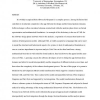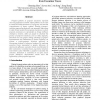67 search results - page 9 / 14 » Representing Embedded System Sequence Diagrams as a Formal L... |
FLAIRS
2008
13 years 9 months ago
2008
One of the central problems in building broad-coverage story understanding systems is generating expectations about event sequences, i.e. predicting what happens next given some a...
JCSS
2011
13 years 2 months ago
2011
It is widely recognised that software development is a complex process. Among the factors that contribute to its inherent complexity is the gap between the design and the formal a...
ICTAI
2008
IEEE
14 years 1 months ago
2008
IEEE
Frequent patterns in program executions represent recurring sequences of events. These patterns can be used to reveal the hidden structures of a program, and ease the comprehensio...
EDOC
2006
IEEE
14 years 1 months ago
2006
IEEE
The correctness of business process models is of paramount importance for the application on an enterprise level. A severe problem is that several languages for business process m...
ISOLA
2004
Springer
14 years 22 days ago
2004
Springer
Abstract. Lurette is an automated testing tool dedicated to reactive programs. The test process is automated at two levels: given a formal description of the System Under Test (SUT...


